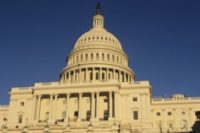A rider included the U.S. Senate’s proposed fiscal year 2016 budget would block funding related to silica exposure regulations until additional studies are done.
The amendment defunds action on OSHA’s proposed silica rule until a small business impact panel is conducted and several studies are completed by the National Academy of Sciences. The studies include the ability of affected industries to comply with the new standard and the ability of commercial laboratories to measure silica accurately and consistently.
2.2 million workers
Breathing in tiny bits of silica causes silicosis, a chronic and irreversible lung disease. People who work in sandblasting, mining, construction and many other industries are at risk for silicosis. Approximately 2.2 million workers currently are exposed to silica, which, in addition to causing lung cancer, has contributed to 1,437 silicosis-related deaths between 2001 and 2010.
Critics of the rider, which include Public Citizen, the National Council for Occupational Safety and Health (National COSH) and dozens of worker safety, labor, good government, public health, environmental and community groups, says OSHA’s proposed rule to limit occupational exposure to silica is based on decades of extensive, peer-reviewed research on the hazards of silica exposure.
Existing research
The National Institute for Occupational Safety and Health (NIOSH) released a Hazard Review in 2002: Health Effects of Occupational Exposure to Respirable Crystalline Silica, which describes published studies and literature on the health effects of occupational exposure to respirable crystalline silica among workers in the U.S. and many other countries. Occupational exposures to respirable crystalline silica are associated with the development of silicosis, lung cancer, pulmonary tuberculosis, and airways diseases. These exposures may also be related to the development of autoimmune disorders, chronic renal disease, and other adverse health effects.
The National Stone, Sand and Gravel Association (NSSGA) says OSHA’s proposal to reduce the current exposure limit “is not supported by sound science and will create a tremendous financial burden for many industrial sectors.”
NSSGA vowed to “work to see that the silica amendment is included” if an omnibus appropriations bill is required at the end of the calendar year.
OSHA estimates that the new standard (if funded) will save nearly 700 lives and prevent 1,600 new cases of silicosis per year once the full effects of the rule are realized.



